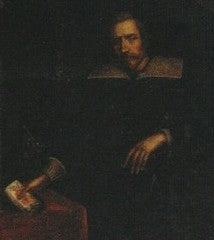Francesco Fibbia and the Origins of the Bolognese Tarot

In an old palace in Bologna hangs a mysterious 16th-century painting. It shows Prince Francesco Fibbia seated at a table, a deck of cards before him, as three fall to the ground. At the bottom of the canvas, an inscription attributes to him the invention of the Small Tarot of Bologna. Yet scholars remain divided: is this historical fact or family legend?
The Castracani Legacy

From here, the genealogical record becomes murky. Some sources—such as the Benedictine monk Flaminio Fibbia (1594)—describe Francesco as the son of Rolando and grandson of Enrico Castracani. Others, including a testament of 1561, present him instead as Castruccio’s direct grandson, exiled from Lucca after 1328 and later established in Bologna.
A Prince Between Two Cities
Despite these contradictions, tradition firmly links Francesco Fibbia to Bologna. The famous painting preserved in the Palazzo Fibbia (formerly on Via San Donato, now Piazza Malpighi) depicts him not only as a nobleman but as a symbolic inventor of the city’s tarot.
In the artwork, Francesco sits solemnly at a table. Beside him lies a deck of the Small Tarot of Bologna, while on the floor three cards are clearly visible: the Queen of Batons, the Queen of Coins, and another card slipping from his hand.
Beneath the image, an inscription summarizes his remarkable life:

“Francesco Antelminelli Castracani Fibbia, Prince of Pisa, Montegiori, and Pietrasanta, Lord of Fucecchio, son of Giovanni, descended from Castruccio, Duke of Lucca, Pistoia, and Pisa. Fleeing to Bologna, he entered the service of the Bentivoglio family, was named general of their armies, and became known as ‘Dalle Fibbie’. He married Francesca, daughter of Giovanni Bentivoglio.”
Francesco Fibbia and the Myth of the Bolognese Tarot
The tradition that credits Prince Francesco Fibbia with inventing the Small Tarot of Bologna does not withstand historical scrutiny. Fibbia died in 1419—decades before the first documented tarots appeared in northern Italy (c.1440). Even more, the so-called “Small Tarot” of Bologna was itself a later simplification of the Milanese model.
So where does this claim originate? Most likely from a 17th-century reinterpretation. The oil painting preserved in Bologna, which depicts the prince seated at a table with cards in his hand, bears a later inscription proclaiming him as the game’s inventor. Rather than a true testimony, this was an attempt to ennoble the Fibbia name by attaching it to a cultural innovation that had already gained prestige.
Family Arms on the Cards
The arms of the Fibbia family did indeed appear on certain Bolognese tarot cards—specifically the Queen of Batons and the Queen of Coins. Yet this is more plausibly explained as a symbol of political alliance rather than genealogical invention. Nobility often stamped their heraldry on popular games or objects as a sign of patronage, not authorship.
Echoes in Religious Art

Defenders of the legend have also tried to link early Bolognese frescoes to the tarot. In the Basilica of San Petronio, painted around 1415, appear figures of Satan and an Idolater chained together—images that some claim prefigure the tarot’s Devil card. But these depictions, while striking, have no real continuity with the fully developed tarot trumps. They are isolated motifs, not part of a structured system.
The oldest coherent tarot cycle remains the Visconti-Sforza deck, created in Milan around 1440—two decades after Fibbia’s death.
A Legend of Legacy
In the end, the link between Francesco Fibbia and the tarot appears to be a later invention, likely crafted by his descendants to glorify their lineage. The painting, with its evocative imagery of cards falling from the prince’s hand, gave fertile ground for such myths to grow.
But history tells another story: the tarot was born not in Bologna, but in the courts of Milan, and its association with Fibbia is better understood as a legend of pride rather than fact.

“The main square of Bologna.”